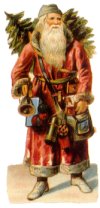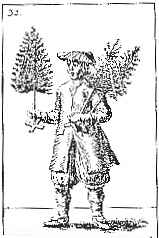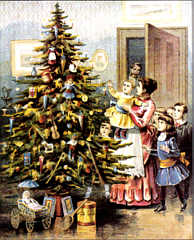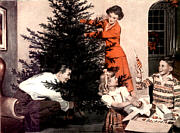The History of Christmas Ornaments

"The reflections of candles in the brilliantly colored ornaments on the Christmas tree aren't the final stage in a steady development. Just as the Christmas festival as we know it hasn't always been celebrated since the birth of Christ. How then did it come to the glass ornaments that bring a sparkle to the otherwise so dull Winter days? As it often is, the scholars are divided when it comes to Christmas and for this reason the origins of the Christmas tree and Christmas decorations can explained in many different ways.
The fact that the Christmas-tree has it's origins in Europe's pre-Christian age has been proven by many scholars. The Christmas-tree is possibly a descendant of the old Germanic Yule-tree or the light-tree that was supposed to offer shelter from unwanted spirits on the cold Winter nights. Even a connection to the "Paradise Tree" with red apples and the Fall of Man has been suggested; many explanations are offered.
The first documented mention of "Christmas greens" was made in 1494 in , Narrenschiff" from Sebastian Brant. There it is written: .... . und wer nit etwas nuwes hat und um das nuw jor singen gat und grün tannris steckt in sind huus, der meint, er lebt das jor nit .us... [and he who has received nothing new, and finds no joy in the new year and sets twigs of fir his house, believes he will not live life to the full in the coming year ]

Dancing and leaping and the giving of gifts, as well as displaying "Dannenreisig" (fir-tree twigs) in the meeting places is seen as a heathen right. This is documented in a sermon from the Geiler von Kaiserberg in Salzburg in the year 1508.
In 1525 in Salzburg an official decree relating to the chopping off of Christmas twigs was issued. Even at this early stage, environmental reason played a roll due to "forestall disadvantages", as did "superstitious beliefs". These heathen Christmas bushes first developed into bundles and then later into the whole tree. . In 1605 the first documented Christmas-tree is publicly erected in Straßburg.
It is without candles, but is decorated with bright red apples. In 1611 the first Christmas tree as we know it is documented. It stood in the Manor of the Dutch Dorothea Sybille of Schlesien in Breslau. 1870 Justus Liebig from the town of Morgenstern near Gablonz invented the craft of lining glass objects from the inside with silver. The Krebs family also come from Gablonz and produces glass Christmas-tree ornaments in Rosenheim today.
In 1878 the Sonneberger Chamber of Commerce speaks of the "fast growing, intake" of glass Christmas ornaments from Thüringen. The glassblowers of Bohemia (Gablonz) were expelled to Thüringen during the course of the counter- reformation.

By 1893 glass ornaments and the Christmas tree had become an inseparable part of German households. Even at that time the leading women's magazine gave tips relating to the fashionable decoration o the tree: "The tree must glow, twinkle, glitter and sparkle"(Gartenlaube 1893).
Today, the custom of decorating the Christmas-tree and glass ornaments has spread throughout world, and so, this purely German custom has loosened itself from Christian symbolism and can be found worldwide Japan, South America, Africa or Australia.
Where the Christmas-tree came from has been clarified to some degree, what about the sparkling red, golden or silver ornaments hanging on the tree? In the beginning, one could find red apples and gilded nuts, but also sugar-sweets and small toys were seen in the early stages. As always, there are many explanations as to where this custom came from.
Some argue (remembering the "Paradise Tree") that the apple is a symbol of the Fall of Man and the expulsion from the Garden of Eden and for the yearning thereafter. The following explanation seems more evident though, as the apple was used before the Christmas tree was claimed by the Church. In the hard Winter months, fruit used to be scarce and the Winter Solstice signified the turning towards the new year and the new harvest. This was celebrated by consuming stored winter apples, and, similar to today, this festival was accompanied by special meals and dishes.
Food and tree were combined and so the Christmas tree decorated with fruit and sweets was born. In the upper classes this manner of decorating the tree was transformed, and so, the fruit which was at first gilded was later replaced by silvered glass ornaments. This explains why the first documented accounts are found among the upper class and why the tradition of decorating trees with sparkling ornaments was spread among the upper class.
Today, glass Christmas tree ornaments and the Christmas tree have become inseparable. Recent representative surveys have shown that 74% of all Germans decorate their tree with original glass ornaments.

Following the "Secondary Tree" that can be found in many gardens, laden with electric candles, the trend nowadays moves toward the "Children's Tree"that is set up directly in the children's room. This tree is decorated with ornaments that is in accordance with the tastes of the children, showing designs with Mickey Mouse, etc.
Additional information about Christmas Ornaments..."In the early 1800's, trees were decorated with home-baked cookies, cakes and handmade ornaments such as cotton-batting Santas and silver paper cornucopias. From 1870-1910, the golden era of Victorian Christmas ornaments, the tree glowed with glass figures in scores of shapes, sometimes decorated with crinkled gold or silver, with the glorious hand-blown, heavy glass globes called "kugels"; and with Dresdens, the most exquisite paper ornaments ever created.
In addition to the Dresdens, Nuremberg Angels were prized tree ornaments. Named after her place of origin, a Nuremberg Angel wore a crinkled gold skirt, spun-glass wings, and a sweet innocent face made of wax or clay bisque. Sometimes she carried a silver-lettered scroll that read "Peace on Earth" as she spun round and round, suspended over the tree."
Christmas With Love Hosted and Written by (unless otherwise specified) Jaci Rae.
Copyright, Jaci Rae and North Shore Records, Inc.


